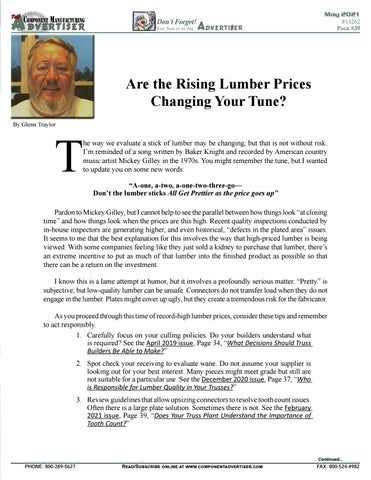A
Th e
Component Manufacturing dverti$ dverti $ er
Don’t Forget! You Saw it in the
Adverti$$er
May 2021 #13262 Page #39
Are the Rising Lumber Prices Changing Your Tune? By Glenn Traylor
T
he way we evaluate a stick of lumber may be changing, but that is not without risk. I’m reminded of a song written by Baker Knight and recorded by American country music artist Mickey Gilley in the 1970s. You might remember the tune, but I wanted to update you on some new words: “A-one, a-two, a-one-two-three-go— Don’t the lumber sticks All Get Prettier as the price goes up”
Pardon to Mickey Gilley, but I cannot help to see the parallel between how things look “at closing time” and how things look when the prices are this high. Recent quality inspections conducted by in-house inspectors are generating higher, and even historical, “defects in the plated area” issues. It seems to me that the best explanation for this involves the way that high-priced lumber is being viewed. With some companies feeling like they just sold a kidney to purchase that lumber, there’s an extreme incentive to put as much of that lumber into the finished product as possible so that there can be a return on the investment. I know this is a lame attempt at humor, but it involves a profoundly serious matter. “Pretty” is subjective, but low-quality lumber can be unsafe. Connectors do not transfer load when they do not engage in the lumber. Plates might cover up ugly, but they create a tremendous risk for the fabricator. As you proceed through this time of record-high lumber prices, consider these tips and remember to act responsibly. 1. Carefully focus on your culling policies. Do your builders understand what is required? See the April 2019 issue, Page 34, “What Decisions Should Truss Builders Be Able to Make?” 2. Spot check your receiving to evaluate wane. Do not assume your supplier is looking out for your best interest. Many pieces might meet grade but still are not suitable for a particular use. See the December 2020 issue, Page 37, “Who is Responsible for Lumber Quality in Your Trusses?” 3. Review guidelines that allow upsizing connectors to resolve tooth count issues. Often there is a large plate solution. Sometimes there is not. See the February 2021 issue, Page 39, “Does Your Truss Plant Understand the Importance of Tooth Count?”
Continued...
PHONE: 800-289-5627
Read/Subscribe online at www.componentadvertiser.com
FAX: 800-524-4982
